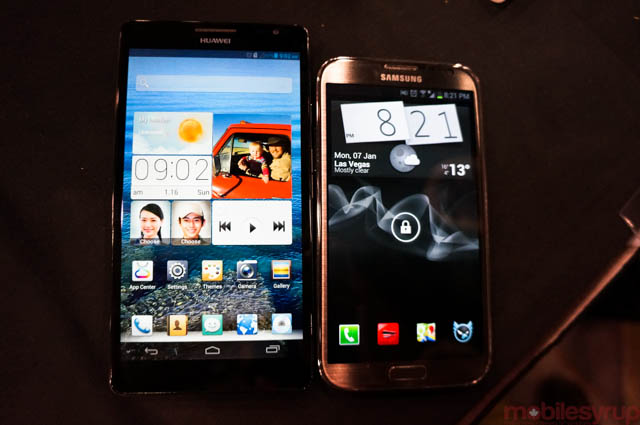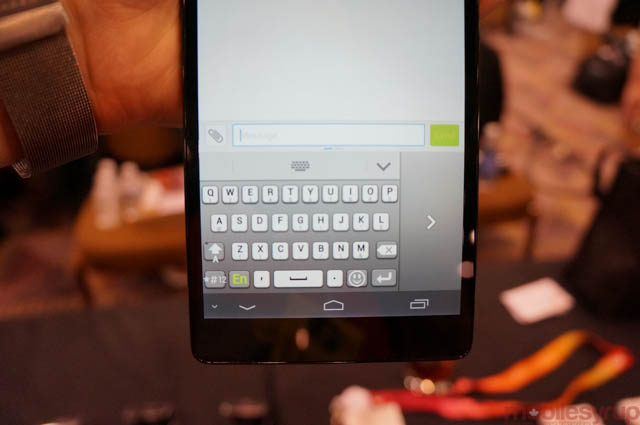
It’s hard to tell the scale of the above photo, but the device on the left is 6.1-inches, dwarfing the 5.5-inch Galaxy Note II to its right. The Huawei Ascend Mate is huge: too big for most pockets and absurd to hold up to your ear.
But it seems that manufacturers plan to break the 6-inch barrier this year. Samsung’s rumoured Galaxy Note III will almost certainly bigger than its two predecessors, a natural reaction to an industry that seems to value screen size over portability. The trend seems to have been cemented by Apple’s tacit acknowledgement that the 3.5-inch screen it once deemed perfect for one-handed use was too small for its millions of users.
Android manufacturers have taken this oneupmanship to a whole new level. The Galaxy series is a perfect example of this: the 4-inch Galaxy S ballooned to 4.3-inches and then to 4.8. The Note went from 5.3 to 5.5 and may broach 6 by the end of this year. Huawei’s introduction of the Ascend Mate introduces yet another hand-busting form factor to contend with.
But at what point will manufacturers stop the madness? Will small devices with have to become “retro” to be introduced to the market? There are certainly benefits to larger screens and sharper displays but the game of “who first?” has become a little bit ridiculous. Refer to the Galaxy S III mini which, at 4-inches, is a midrange device. It would appear that manufacturers are no longer interested in making high-end smartphones under 4.7-inches.

The issue boils down to more than screen size; when the first 720p displays were being sourced, screen manufacturers like Sony, Sharp, Samsung and LG were limited by the size of the panels they could produce. While the Windows Phone 8X eventually got 720p down to 4.3-inches — which some would say is an ideal form factor — the first 720p panels were 4.65-inches or bigger due to manufacturing constraints. The same thing appears true of the first Sharp-, LG- and Sony-made 1080p displays; until the manufacturing process is optimized, the devices will be 5-inches or more. The HTC M7 is purportedly going to be 4.7-inches and have a 1080p display, but that’s yet to be confirmed.
The other issue is battery life: higher pixel count translates into more backlight LEDs and higher GPU clock speeds. Physically larger devices accomodate more capacious batteries, the one area in smartphone design lacking true evolution. Cortex-A15 is going to complicate the situation by upping clock speeds and increased wattage; the reference design can push peak output to 11W (though it will never reach more than a couple Watts when it eventually comes to smartphones).
This has an unfortunate side effect of normalizing untenable year over year increases in smartphone size. I’m not denigrating the ‘phablet’ — which is a terrible moniker — but at 5.5-inches the Galaxy Note II is just too big for the average consumer. Even the Galaxy S III, with its markedly reduced bezel, errs on the side of awkward for one-handed use. It may not be long before 5.5-inches is the new normal.
We’re at a point now where the industry has to decide whether it will continue supersizing its smartphones or, whether at 5-inches we’ve plateaued and can now concentrate on differentiating in more productive ways. I don’t think anyone thought the 6.1-inch Ascend Mate was necessary — not even Huawei itself. It merely transcribed its interpretation of the ‘successful smartphone’ cheat sheet: more inches, more cores, more stuff.
At some point soon there is going to be pushback from consumers against the growing smartphone footprint. Flagship devices can’t get much bigger than 5 inches without a clear delineation between regular and extra large.
MobileSyrup may earn a commission from purchases made via our links, which helps fund the journalism we provide free on our website. These links do not influence our editorial content. Support us here.


